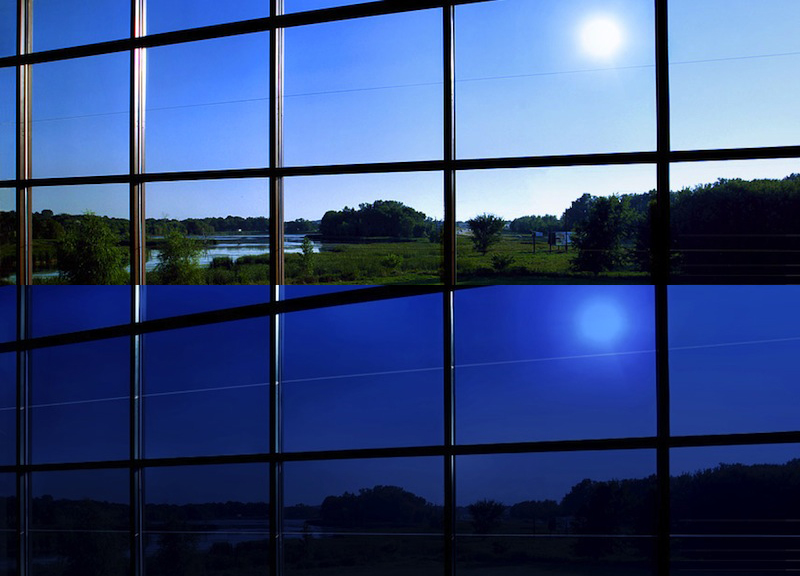New glazing technology is rapidly unfolding. Currently available technologies are seeing performance gains, and cutting-edge products and systems continue to gain a foothold in the mainstream.
Examples of such technologies include:
1. State-of-the-art IGUs. In addition to construction improvements like warm-edge spacers, IGUs are beginning to benefit from alternatives to gas fills. Aerogel insulation, made of synthetic solids that consist almost entirely of air, exhibits extremely low thermal conductivity. Some aerogels can be integrated with polycarbonate sheets to form a translucent cladding material, while others, such as silica aerogels in granular form, can fill the spaces between the glass lites of insulating units, says Ajla Aksamija, PhD, LEED AP BD+C, CDT, Building Technology Researcher with design firm Perkins+Will.
Aksamija also mentions vacuum-insulated glazing (VIG) units. “These units use a vacuum between lites of glass to raise the assembly’s thermal resistance,” she says. With no gas or fill, conduction and convection are virtually eliminated, which also allows the space between the lites (and total glazing thickness) to be greatly reduced, enhancing design flexibility. Patterson notes that vacuum glazing holds the most promise for producing vision glass with a U-factor good enough to justify continuing to build highly glazed facades. He cautions, however, that “a viable solution for widespread application seems to remain beyond the horizon.”
2. Electrochromic glass. Often called smart glass, electrochromic glazing alters its transmittance characteristics when an electrical current is applied, through the use of a specialized lamination that essentially integrates shading into the glazing unit. For instance, one type of smart glass appears frosted until the current is applied, at which point it becomes nearly transparent.
This technology has been in the works for some time, but cost has been a drag on broad market acceptance. There have been problems with the sealants, which are part of the system that carries the electrical current, says Joshua Zinder, AIA, Founding Principal of Joshua Zinder Architecture + Design, who has worked with the products on several occasions.
“A broken seal means a lost electrical connection in the lamination field, which means a loss of the electrochromic functionality in one or more adjacent panels,” he warns, but manufacturers are working to address this problem. “Electrochromic glazing appears to be on the verge of widespread adoption,” says Mic Patterson, Vice President of Strategic Development for Enclos. “The industry has recently invested in the manufacturing infrastructure necessary to produce materials with the right combination of aesthetic and performance attributes at a tolerable price point. These dynamic glazing materials still leave the problem of thermal performance.” Nevertheless, more use of smart glass is likely due to its flexible VLT, which can be integral to daylighting strategies that reduce illumination loads.
3. Building-integrated photovoltaics. In recent years, BIPV systems have shown signs of living up to their promise. With improvements in thin-film PV products to performance levels needed for use in vision glazing, they are getting closer to those of solid solar cells, used in spandrels and shading devices.
Façade orientation and inclination angle are both crucial to the successful integration of PV technology, and the improvement of thin films means that more of a project’s façade area can be integrated for solar harvesting without sacrificing transparency or translucence. Of course, BIPV is an energy-producing technology, not an energy-managing one: Passive solar, which works by managing the temperature of internal thermal mass, according to Cousins, is more closely associated with energy-managing techniques.
One cutting-edge technology is the integrated concentrating solar façade, or ICSF, currently in development by the Center for Architecture Science and Ecology (http://www.case.rpi.edu), a collaboration between Rensselaer Polytechnic Institute and Skidmore, Owings & Merrill. This is a dynamic façade system composed of moving gem-like solar collectors that can harvest daylight and fulfill a number of other energy requirements—heating, cooling, hot water, and electricity production.
4. Phase-change materials. PCMs are solid at room temperature but liquefy at higher temperatures, absorbing and storing heat in the process, says Aksamija. They are currently commercially available integrated into IGUs. Composed of either waxes or salts, PCMs can absorb high exterior temperatures by day and emit the heat to the interior at night.
5. Aluminosilicate glass, which is used to cover the displays of personal digital devices, is extremely thin and highly impact resistant. This glass type is essentially unheard of in building applications, because manufacturing large spans of the glass is prohibitively expensive. However, manufacturers are investing in improving the process because thin, impact-resistant glass could be an enormous boon to architectural glazing.
6. ETFE. Ethylene tetrafluoroethylene is a fluorine-based plastic originally conceived for its anti-corrosive properties, but which also demonstrates benefits for glazing applications, namely low weight, recyclability, and, in double- and triple-ply configurations with a gas fill, excellent thermal properties. But pumps are required to maintain constant air pressure relative to varying wind loads, and (worst-case scenario) when it burns the material releases hydrofluoric acid, which is highly toxic and corrosive.
Editor's note: This article was adapted from our recent AIA CES Discovery course, "Energy-efficiency Glazing Technology." Take the free course.
Related Stories
| May 24, 2012
2012 Reconstruction Awards Entry Form
Download a PDF of the Entry Form at the bottom of this page.
| Mar 29, 2012
U.K.’s Manchester Airport tower constructed in nine days
Time-lapse video shows construction workers on the jobsite for 222 continuous hours.
| Mar 27, 2012
Skanska hires aviation construction expert Bob Postma
Postma will manage Skanska’s nationwide in-house team of airport construction experts who lead the industry in building and renovating airport facilities and their essential features.
| Jan 4, 2012
New LEED Silver complex provides space for education and research
The academic-style facility supports education/training and research functions, and contains classrooms, auditoriums, laboratories, administrative offices and library facilities, as well as spaces for operating highly sophisticated training equipment.
| Nov 10, 2011
Skanska Moss to expand and renovate Greenville-Spartanburg International Airport
The multi-phase terminal improvement program consists of an overall expansion to the airport’s footprint and major renovations to the existing airport terminal.
| Mar 2, 2011
Cities of the sky
According to The Wall Street Journal, the Silk Road of the future—from Dubai to Chongqing to Honduras—is taking shape in urban developments based on airport hubs. Welcome to the world of the 'aerotropolis.'
| Feb 15, 2011
Iconic TWA terminal may reopen as a boutique hotel
The Port Authority of New York and New Jersey hopes to squeeze a hotel with about 150 rooms in the space between the old TWA terminal and the new JetBlue building. The old TWA terminal would serve as an entry to the hotel and hotel lobby, which would also contain restaurants and shops.
| Aug 11, 2010
JE Dunn, Balfour Beatty among country's biggest institutional building contractors, according to BD+C's Giants 300 report
A ranking of the Top 50 Institutional Contractors based on Building Design+Construction's 2009 Giants 300 survey. For more Giants 300 rankings, visit http://www.BDCnetwork.com/Giants
| Aug 11, 2010
Jacobs, Arup, AECOM top BD+C's ranking of the nation's 75 largest international design firms
A ranking of the Top 75 International Design Firms based on Building Design+Construction's 2009 Giants 300 survey. For more Giants 300 rankings, visit http://www.BDCnetwork.com/Giants













